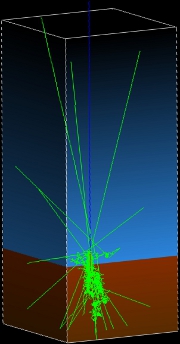A magazine where the digital world meets the real world.
On the web
- Home
- Browse by date
- Browse by topic
- Enter the maze
- Follow our blog
- Follow us on Twitter
- Resources for teachers
- Subscribe
In print
What is cs4fn?
- About us
- Contact us
- Partners
- Privacy and cookies
- Copyright and contributions
- Links to other fun sites
- Complete our questionnaire, give us feedback
Search:
Life on Mars?
Lewis Dartnell, a PhD student at UCL and author of "Life in the Universe: A Beginner's Guide" tells us about his search for life...

I am searching for life on Mars. Now, before you dismiss me as a crank, let me explain...
I carry out research in the field of astrobiology: the study of the 'origin, evolution, distribution and future of life in the Universe'. Mars, our planetary next-door neighbour, has a good chance of harbouring life. The Martian environment billions of years ago was much like Earth's, with a thick warm atmosphere, seas and lakes of water on the surface, and probably lots of interesting organic chemistry going on. The problem is that Mars suffered a cataclysmic environmental collapse.
Most of Mars' atmosphere has blown into space and its surface is a dust-swept, freeze-dried desert. If life did evolve here long ago then it's coping with some pretty unpleasant conditions on the Martian surface right now. The ground is so cold that any bacterial life remaining must be in deep freeze, held dormant in the preserving ice.
Another hazard on the Martian surface is radiation from outer space. Cosmic rays are made up of particles accelerated to near the speed of light by solar flares and exploding stars throughout the galaxy. These energetic particles are extremely dangerous to organisms as they shatter the delicate molecules of life such as DNA and proteins. The Earth is shielded by a strong magnetic field and a nice thick atmosphere, but Mars has been laid bare to this onslaught of radiation. So the big question is, how long can frozen bacteria survive the radiation on Mars' surface before they're all killed off?
We have a good idea what the radiation environment is in space, through measuring it with space probes. No particle detectors have actually landed on Mars though but calculating the radiation levels on, and beneath, the Martian surface is a perfect problem to attack with computer models. That is the essence of my PhD research so far: developing a computer program to handle all of the particle physics going on with this high-energy radiation, feeding in all the information about the properties of the Martian atmosphere and surface, deciding what data would be meaningful for the model to output, and then letting a network of computers churn through all the complicated maths to produce the desired results.
The image shows a visualisation of the set-up for my computer model. I have designed it with a block of Mars rock beneath a column of atmosphere, realistically layered so that the air gets denser nearer the ground. An energetic cosmic ray (in blue) can be seen approaching Mars from outer space, punching straight through the thin atmosphere and then triggering a great shotgun blast of radiation underground (the red and green cascade). I need information like how many radiation particles are created, of which kind, and what radiation dose they deposit within bacterial cells living at different depths underground. That allows me to work out how long cells might survive.

The particle physics going on inside these radiation cascades is enormously complicated, with millions of new particles being created from each original cosmic ray, of tens of different kinds, and all interacting in different ways. The program uses a common trick of computer models to work out what to do at each step in time it simulates. During every time-step each of these fast-moving particles can decay, move forward, or collide into something - interacting in many different ways. Physicists have worked out the probability of each happening. All the computer model needs to do to simulate every time-step then is pick a random number and check which of the possibilities this relates to. This is like rolling large multi-sided dice, looking the result up in a table of possible outcomes. It's called a "Monte Carlo" simulation, after the famous gambling casino resort.
After I've modelled the complete cascades generated by large numbers of original cosmic ray particles and calculated the radiation dose at different depths beneath Mars' surface I can use these to approximate how long bacteria might survive at different depths.
The answer? Well the longest drill that space engineers have so far designed for a probe bound for Mars is 2 metres. Looking at that depth even the most radiation resistant bacteria known would be killed off in less than half a million years.
It looks like we're either going to have to drill deeper to find surviving life on Mars, or land our probes at special locations where life may have been brought to the surface very recently. Not bad from a computer model that simulates space radiation by rolling a few dice ... several billion times...


